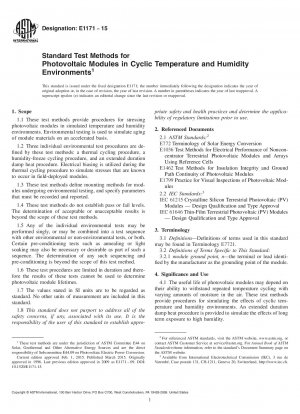ASTM E1171-15
Standard Test Methods for Photovoltaic Modules in Cyclic Temperature and Humidity Environments
- Standard No.
- ASTM E1171-15
- Release Date
- 2015
- Published By
- American Society for Testing and Materials (ASTM)
- Status
- Replace By
- ASTM E1171-15(2019)
- Latest
- ASTM E1171-15(2019)
- Scope
4.1 The useful life of photovoltaic modules may depend on their ability to withstand repeated temperature cycling with varying amounts of moisture in the air. These test methods provide procedures for simulating the effects of cyclic temperature and humidity environments. An extended duration damp heat procedure is provided to simulate the effects of long term exposure to high humidity.
4.2 The durations of the individual environmental tests are specified by use of this test method; however, commonly used durations are 50 and 200 thermal cycles, 10 humidity-freeze cycles, and 1000 h of damp heat exposure, as specified by module qualification standards such as IEC 61215 and IEC 61646. Longer durations can also be specified for extended duration module stress testing.
4.3 Mounting—Test modules are mounted so that they are electrically isolated from each other, and in such a manner to allow free air circulation around the front and back surfaces of the modules.
4.4 Current Biasing:
4.4.1 During the thermal cycling procedure, test modules are operated without illumination and with a forward-bias current equal to the maximum power point current at standard reporting conditions (SRC, see Test Methods E1036) flowing through the module circuitry.
4.4.2 The current biasing is intended to stress the module interconnections and solder bonds in ways similar to those that are believed to be responsible for fill-factor degradation in field-deployed modules.
4.5 Effects of Test Procedures—Data generated using these test methods may be used to evaluate and compare the effects of simulated environment on test specimens. These test methods require determination of both visible effects and electrical performance effects.
4.5.1 Effects on modules may vary from none to significant changes. Some physical changes in the module may be visible when there are no apparent electrical changes in the module. Similarly, electrical changes may occur with no visible changes in the module.
4.5.2 All conditions of measurement, effects of cycling, and any deviations from this test method must be described in the report so that an assessment of their significance can be made.
4.6 Sequencing—If these test methods are performed as part of a combined sequence with other environmental or non-environmental tests, the results of the final electrical tests (6.2) and visual inspection (6.3) determined at the end of one test may be used as the initial electrical tests and visual inspection for the next test; duplication of these tests is not necessary unless so specified.
1.1 These test methods pr......
ASTM E1171-15 Referenced Document
- ASTM E1036 Standard Test Methods for Electrical Performance of Nonconcentrator Terrestrial Photovoltaic Modules and Arrays Using Reference Cells
- ASTM E1462 Standard Test Methods for Insulation Integrity and Ground Path Continuity of Photovoltaic Modules
- ASTM E1799 Standard Practice for Visual Inspections of Photovoltaic Modules
- ASTM E772 Standard Terminology Relating to Solar Energy Conversion
ASTM E1171-15 history
- 2019 ASTM E1171-15(2019) Standard Test Methods for Photovoltaic Modules in Cyclic Temperature and Humidity Environments
- 2015 ASTM E1171-15 Standard Test Methods for Photovoltaic Modules in Cyclic Temperature and Humidity Environments
- 2009 ASTM E1171-09 Standard Test Methods for Photovoltaic Modules in Cyclic Temperature and Humidity Environments
- 2004 ASTM E1171-04 Standard Test Methods for Photovoltaic Modules in Cyclic Temperature and Humidity Environments
- 2001 ASTM E1171-01 Standard Test Method for Photovoltaic Modules in Cyclic Temperature and Humidity Environments
- 1999 ASTM E1171-99 Standard Test Method for Photovoltaic Modules in Cyclic Temperature and Humidity Environments

Copyright ©2024 All Rights Reserved